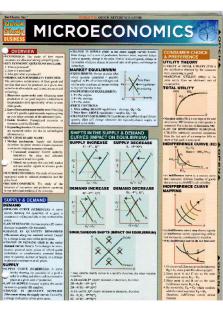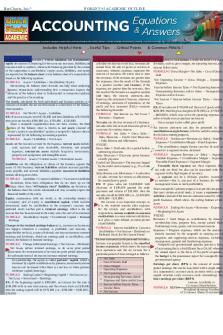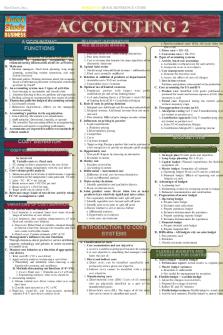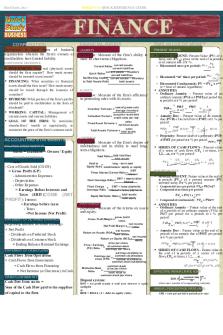Quick Study Academic Accounting Equations & Answers PDF

| Title | Quick Study Academic Accounting Equations & Answers |
|---|---|
| Course | Regnskab |
| Institution | Syddansk Universitet |
| Pages | 6 |
| File Size | 489.5 KB |
| File Type | |
| Total Downloads | 397 |
| Total Views | 539 |
Summary
Balance SheetAssets are economic resources, whereas liabilities and stockholders’ equity are sources of financing for the economic resources; liabilities are amounts owed to creditors, whereas the financing provided by the owners of the corporation is stockholders’ equity; assets, liabilities, and e...
Description
BarCharts, Inc. ®
WORLD’S #1 ACADEMIC OUTLINE
Essential Information for Understanding Key Accounting Principles & Methodologies Includes Helpful Hints , Useful Tips , Critical Points & Common Pitfalls ! Balance Sheet
Income Statement & Retained Earnings
Assets are economic resources, whereas liabilities and stockholders’ equity are sources of financing for the economic resources; liabilities are amounts owed to creditors, whereas the financing provided by the owners of the corporation is stockholders’ equity; assets, liabilities, and equity are reported on the balance sheet; every balance sheet of a corporation is based on the following equation: FORMULA Assets = Liabilities + Stockholders’ Equity Memorizing the balance sheet formula can help when analyzing business transactions; understanding how a transaction impacts the elements of the balance sheet is fundamental to transaction analysis and the practice of accounting
The income statement contains a formula to calculate net income or net loss; revenues are earned from the sale of goods or services to customers, whereas expenses represent the amount of resources the entity used to earn the revenues; if the revenues are greater than the expenses, then the result of the formula is a positive number (net income); if the expenses are greater than the revenues, then the result of the formula is a negative number (net loss); the income statement—also known as the statement of income, statement of earnings, statement of operations, or the profit and loss statement (P&L)—contains the following formula: FORMULA Net Income (or Net Loss) = Revenues – Expenses Net sales are the true revenue of a business; net sales take into account discounts given to customers for various reasons FORMULA Net Sales = Gross Sales – Sales Discounts – Credit Card Discounts – Sales Returns and Allowances WHERE: Gross Sales = Total sales for a period before subtracting discounts Sales Discounts = Discounts given because of early payment Credit Card Discounts = The amount charged by the credit card company (e.g., 3% of sale amount) Sales Returns and Allowances = A reduction of sales revenue for returns or allowances for unsatisfactory goods EX: If gross sales are $1,000,000 with discounts of $100,000 granted for early payments and returns of $20,000, then the net sales would be $880,000 (i.e., $1,000,000 – $100,000 – $20,000) Net income is an important concept, as it is the residual amount after expenses for the owners and stockholders; with corporations, income available to common stockholders is a more relevant calculation, as it gives a more refined, accurate picture of profitability FORMULA Income Available to Common Stockholders = Net Income – Dividends on Preferred Stock for the Current Period
Net worth, calculated for both individuals and business entities, is a measure of wealth; the net worth formula is a derivative of the balance sheet equation FORMULA Net Worth = Assets – Liabilities EX: If you own assets worth $750,000 and have liabilities of $250,000, then your net worth is $500,000 (i.e., $750,000 – $250,000) Since a nonprofit organization does not have owners, the third section of the balance sheet is known as net assets (instead of owner’s equity or stockholders’ equity); a nonprofit’s balance sheet is represented by the following accounting equation: FORMULA Assets = Liabilities + Net Assets Assets are the resources owned by the business; current assets include cash, accounts and notes receivable, inventory, and prepaid expenses; noncurrent assets include long-term investments, property and equipment, and intangible assets FORMULA Assets = Current Assets + Noncurrent Assets Liabilities are the obligations or claims of the business against the assets of that business; current liabilities include accounts payable, notes payable, and accrued liabilities payable; noncurrent liabilities include all long-term debts FORMULA Liabilities = Current Liabilities + Noncurrent Liabilities Sometimes firms have obligations that do not show up on the balance sheet; these “off balance sheet” liabilities are footnotes to the balance sheet but can be substantial and may someday impact the financial health of the entity Equity, synonymous with net worth, is the ownership interest in a company; part of equity is contributed capital, which includes investments made by stockholders in the company’s common and preferred stock; another part is retained earnings, which is the net income that has been invested in the entity since the start of its existence FORMULA Stockholders’ Equity = Contributed Capital + Retained Earnings Changes to the retained earnings balance (i.e., increases or decreases) can happen whenever a company is profitable (net income), is unprofitable (net loss), or pays dividends; net income increases retained earnings and dividends, which are earnings paid to stockholders, and reduces the balance of retained earnings FORMULA Change in Retained Earnings = Net Income – Dividends Net losses reduce retained earnings, as do some prior period adjustments for overstatement of net income; prior period adjustments for understatement of net income increase retained earnings In a partnership, the equity is called partners’ capital, which is increased by capital contributions by partners (investment) and net income and decreased when there is a net loss or when partners withdraw capital (drawings) FORMULA Ending Capital = Beginning Capital + Net Income (or – Net Loss) + Investment – Drawings EX: If the beginning capital is $500,000, net income for the year is $100,000 with no new investments, and the owners draw out $30,000, then the ending capital will be $570,000 (i.e., $500,000 + $100,000 – $30,000)
Income statements can be presented in various formats; one popular format is the classified income statement, which shows the income from operations and the net income for a particular period of time arranged as follows: + – = – = ± = – =
Net Sales Cost of Goods Sold Gross Margin Operating Expenses Net Operating Income Nonoperating Revenues and/or Expenses and Gains and/or Losses Income before Income Taxes Income Taxes Net Income
The calculation of net income is really the result of several formulas, such as gross margin, net operating income, and income before taxes: FORMULAS Gross Margin = Net Sales – Cost of Goods Sold Net Operating Income = Gross Margin – Operating Expenses Income before Income Taxes = Net Operating Income + Nonoperating Revenues and/or Gains – Nonoperating Expenses and/or Losses Net Income = Income before Income Taxes – Income Taxes EX: If net sales are $750,000 and the cost of goods sold is $600,000, then the gross margin is $150,000 (i.e., $750,000 – $600,000), which must cover the operating expenses in order to break even or produce net income Gross margin is also called gross profit An income statement can also be presented in the contribution margin format, which is useful to managers for decision-making purposes FORMULA Net Income = Revenues (or Sales) – Variable Expenses = Contribution Margin – Fixed Expenses The contribution margin format can also be used to construct a segment income statement FORMULA Segment Revenue (or Sales) – Segment Variable Expenses = Contribution Margin – Segment Traceable Fixed Expenses = Segment Margin Traceable fixed expenses are those expenses that not only are fixed but also can be associated with the segment with a high degree of accuracy A segment can be a division, product, customer, or territory—that is, any part of a business for which management wants to track profitability Since a nonprofit’s primary purpose is to provide programs that meet certain societal needs, it issues a statement of activities (instead of the income statement issued by a forprofit business), which shows the ending balance of net assets FORMULA Ending Net Assets = Revenues – Expenses + Beginning Net Assets WHERE: Revenues = Such things as contributions by donors, membership dues, program fees, money earned from fundraising events, grants, and investment income Expenses = Program expenses, which are the amounts directly incurred by the nonprofit in carrying out its programs and supporting-services expenses, including management, general, and fundraising expenses Nonprofit and governmental agencies practice a form of accounting that is a bit different from GAAP; whereas the annual report is the focus of for-profit companies, the budget is the preeminent report for a nonprofit and governmental agency Earnings per share (EPS) is the amount of currentperiod earnings that can be associated with a single share of a corporation’s common stock; an entity with a simple capital structure (only common stock outstanding) has basic earnings per share (BEPS) Income Available to Common Sha reholde rs FORMULA BEPS = Weighted-A Average Number of Common Shares Outstanding
Income Statement & Retained Earnings ( continued ) WHERE: Income Available to Common Shareholders = Net Income – Preferred Dividends The weighted-average number of common shares outstanding is determined by keeping track of the portion of the year that a particular balance of shares is outstanding and using those proportions to calculate weights for an average; for example, if 300,000 shares are outstanding for 3 out of 12 months, a 25% weight will be applied to the 300,000 balance
Investors track EPS diligently by watching FORMULA Ending Retained Earnings = Beginning Retained Earnings + Net Income – Dividends EPS trends (i.e., growth over time) and how close EX: If the year starts with a $500,000 balance in retained earnings, actual EPS is to the expected EPS and during the year the company earns $200,000 in net income The statement of retained earnings shows and pays the stockholders $50,000 in the form of a cash dividend, the increases and decreases that occurred in the then the ending retained earnings balance will be $650,000 (i.e., retained earnings of a company during a particular $500,000 + $200,000 – $50,000) period of time; ending retained earnings are Retained earnings are a type of financing from within the calculated as follows: company (as opposed to financing from external sources)
Statement of Cash Flows The statement of cash flows shows the changes in a company’s cash position during a particular period of time; the change in cash is calculated as follows: FORMULA Change in Cash = ± CFO ± CFI ± CFF WHERE: CFO = Cash flows from operating activities CFI = Cash flows from investing activities CFF = Cash flows from financing activities Cash flows from operating activities (CFO) are part of the statement of cash flows; they are reported along with cash flows from investing activities and cash flows from financial activities FORMULA CFO = Cash from Customers + Interest + Dividends – Cash to Suppliers and Employees – Interest Paid – Income Taxes Paid An estimate of CFO can also be made by using information from the company’s income statement and balance sheet FORMULA CFO = Net Income + Depreciation + Amortization + Other Noncash Charges (income) – Increase in Net Working Capital (or + Decrease in Net Working Capital) The net working capital formula is Net Working Capital = Current Assets – Current Liabilities Cash flows from investing activities (CFI) are gains (or losses) from investments in the financial markets and operating subsidiaries and changes resulting from amounts spent on investments in capital assets such as plant and equipment FORMULA CFI = Sale of Plant and Equipment – Losses from Investment – Investment in Plant and Equipment
When analyzing a company’s cash flow statement, users should review all the sections to see what contributes to the change in cash; sometimes a firm may have negative overall cash flow for a given period, but if the company can generate positive cash flow from its business operations, the negative overall cash flow may be a result of large investment expenditures, which is not necessarily a bad thing Cash flows from financing activities (CFF) measure the flow of cash between a firm and its owners and creditors FORMULA CFF = Cash Received from Issuing Stock or Debt – Cash Paid as Dividends for Reacquisition of Stock or Payment of Debt
Cash on the balance sheet is often simply cash in the checking account; every checking account should be reconciled periodically to ensure that differences between the balances for cash in the company’s records and the bank statement can be explained; such a process can identify errors on either the part of the bank or the firm FORMULAS Reconciled Balance = Ending Cash Balance per Accounting Records + Interest Paid by Bank – NSF Checks ± Company Errors Reconciled Balance = Ending Cash Balance per Bank Statement + Deposits in Transit – Outstanding Checks ± Bank Errors
significantly more; thus, if the firm has $200,000 of depreciation expense and another $50,000 of amortization expense, both items would be added back to net income to derive an EBDA of $1,250,000 (i.e., $1,000,000 +
Once a statement of cash flows has been prepared, the quality of income can be judged; the quality of income ratio indicates what portion of income was generated in cash
cash flow estimate called earnings before interest, taxes, depreciation,
CFO Net Income EX: With CFO at $150,000 and net income of $300,000, a company’s quality of income ratio would be 0.5 or 50% (i.e., $150,000/$300,000) Estimating the cash flow can be done by calculating earnings before depreciation and amortization (EBDA); also called accounting cash flow, EBDA gives a quick glance or rough estimate of cash flow from an entity for a particular period (e.g., month, quarter, year); to calculate EBDA, the primary noncash expenses—depreciation and amortization—are added back to net income to estimate cash flow FORMULA
Quality of Income Ratio =
Accountants use a system of debits and credits to keep track of account balances; a debit is on the left-hand side of an account, whereas a credit is on the right-hand side; if an account is debited, it means that an amount has been entered on the left-hand side, whereas a credited account has received an amount on the right-hand side; the increase or decrease as a result of debiting or crediting the account depends on the type of account (e.g., asset, liability, equity): •Assets: Debits increase assets, whereas credits decrease assets •Liabilities: Debits decrease liabilities, whereas credits increase liabilities •Equity: Debits decrease equity, whereas credits increase equity FORMULAS Ending Balance of an Asset Account = Beginning Debit Balance + Debits – Credits Ending Balance of a Liability Account = Beginning Credit Balance – Debits + Credits
Bank Reconciliation
EX: Even though a company’s profits are $1,000,000, its EBDA should be
The statement of cash flows reveals the cash balance at the end of the year FORMULA Cash at End of Year = Change in Cash + Cash at Beginning of Year
Accounts
Cash & Receivables
FORMULA EBDA = Net Income + Depreciation + Amortization
•Outstanding checks are written by the company and recorded in the company’s ledger as credits but have not yet cleared the bank •Deposits in transit are deposits sent to the bank that are recorded as debits in the company’s ledger account but have not yet been recorded by the bank •Bank service charges are charged by the bank and listed on the bank account statement but not yet recorded in the company’s cash ledger •NSF checks (a.k.a. bad checks or bounced checks) are deposited but must be deduced from the company’s cash account and recorded as receivables; errors can be made by the bank or the company
$200,000 + $50,000) In valuing a company, a modification of EBDA is done to produce another
and amortization (EBITDA) FORMULA
EBITDA = Net Income +
Interest + Depreciation + Amortization Free cash flow is a quick calculation that helps estimate cash flow beyond what is needed to grow by way of capital expenditures FORMULA Free Cash Flow = CFO – Capital Expenditures
Ending Balance of an Equity Account = Beginning Credit Balance – Debits + Credits When trying to remember the rules of debits and credits, if you can remember that assets are increased by debits and that liabilities and equities (the right-hand side of the balance sheet formula) are increased with credits, you can then deduce that decreases are the exact opposite (i.e., if assets increase with debits, then assets are decreased with credits) The transaction analysis model is a visual way of understanding the math of double-entry accounting; the left side of an account is the debit side, while the right side is the credit side Assets
=
+ Debits – Credits
Liabilities
+
– Debits + Credits
Stockholders’ Equity Contributed Retained Earnings Capital – Debits + Credits + Debits – Credits Revenues & Gains Expenses & Losses – Debits + Credits + Debits – Credits
Accounts Receivable Accounts receivable are promises from customers to pay for goods and services that were purchased on credit; the portion of accounts receivable estimated to be uncollectible is called bad debt expense or uncollectible accounts expense FORMULA Bad Debt Expense = Credit Sales × Bad Debt Loss Rate EX: If a company’s credit sales are $1,000,000 and its bad debt loss rate for the past 5 years has averaged 6%, then its bad debt expense would be $60,000 (i.e., $1,000,000 × 0.06) The bad debt loss rate is calculated as follows:
FORMULA
Bad Debt Loss Rate =
Bad Debt Losses during the Period Total Credit Sall es for the Period
EX: If the bad debt losses during the year were $100,000 and the total credit sales for the same period were $2,000,000, then the bad debt loss rate would be calculated as follows: $100,000/$2,000,000 = 0.05 = 5% Accounts receivable values on the balance sheet are shown net of an allowance (an estimate) of bad debts; the allowance for doubtful accounts is a contraasset account containing the estimated uncollectible accounts receivable FORMULA Net Receivables = Accounts Receivable – Allowance for Doubtful Accounts EX: If the accounts receivable reported on the balance sheet equals $1,500,000 and the allowance for doubtful accounts
Cash & Receivables ( continued ) has a credit balance of $75,000, then the net receivables would be calculated as follows: $1,500,000 – $75,000 = $1,425,000 In estimating bad accounts receivables (uncollectible accounts expense), all the accounts receivable of a company are grouped by age and the balances are multiplied by an estimated loss percentage FORMULA Estimated Uncollectible Receivables = Dollar Amount of Receivables in a Particular Age Group × % Estimated to Be Uncollectible
Each estimated uncollectible amount is the result of an account receivable amount multiplied by an estimated percentage, which is usually developed based on experience Aging Amount Estimated % Uncollectible Estimated Amount Uncollectible Not due yet $100,000 2 $2,000 Up to 90 days past due $50,000 10 $5,000 Over 90 days past due $30,000 30 $9,000 Estimated ending balance in the allowance for doubtful accounts $16,000
Inventory
Property, Plant & Equipment
Inventory is primarily accounted for at its cost, which is the price paid or the value given to acquire an asset; however, inventory cost can include many things, such as all the applicable expenditures and charges incurred to bring an item to its existing condition and location, including the cost to manufacture (absorption costing) and, in the case of purchased inventory, the following: FORMULA Cost of Purchased Inventory = Invoice Cost – Purchase Returns and Allowances – Cash Discounts + Buyer’s Transportation Costs WHERE: Returns = Goods returned to the seller Allowances = Discounts allowed because the goods are not up to the buyer’s expectations Cash Discounts = Discounts allowed by the vendor (supplier) to induce early payment EX: If the invento...
Similar Free PDFs

Accounting Equations and Answers
- 6 Pages

Statistics - Quick Study Guide
- 4 Pages

Accounting Answers
- 3 Pages

Quick Study Micro Econ 1
- 5 Pages
Popular Institutions
- Tinajero National High School - Annex
- Politeknik Caltex Riau
- Yokohama City University
- SGT University
- University of Al-Qadisiyah
- Divine Word College of Vigan
- Techniek College Rotterdam
- Universidade de Santiago
- Universiti Teknologi MARA Cawangan Johor Kampus Pasir Gudang
- Poltekkes Kemenkes Yogyakarta
- Baguio City National High School
- Colegio san marcos
- preparatoria uno
- Centro de Bachillerato Tecnológico Industrial y de Servicios No. 107
- Dalian Maritime University
- Quang Trung Secondary School
- Colegio Tecnológico en Informática
- Corporación Regional de Educación Superior
- Grupo CEDVA
- Dar Al Uloom University
- Centro de Estudios Preuniversitarios de la Universidad Nacional de Ingeniería
- 上智大学
- Aakash International School, Nuna Majara
- San Felipe Neri Catholic School
- Kang Chiao International School - New Taipei City
- Misamis Occidental National High School
- Institución Educativa Escuela Normal Juan Ladrilleros
- Kolehiyo ng Pantukan
- Batanes State College
- Instituto Continental
- Sekolah Menengah Kejuruan Kesehatan Kaltara (Tarakan)
- Colegio de La Inmaculada Concepcion - Cebu











